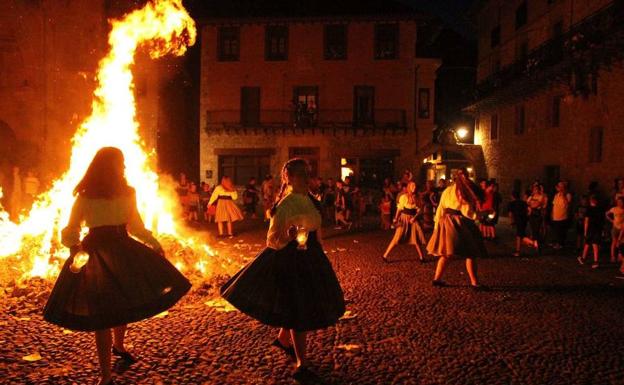The summer solstice, being the longest day of the year, is an important event in many cultures, marking the changing of seasons. Because of its importance, elaborate rituals and rites have arisen around this date all around around the globe, and the Basque Country is no exception. Many of the pre-Christian elements have been confused and combined with Christian holidays, as the Church placed San Juan’s Feast near the Summer solstice. That said, the echo of many elements of pre-Christian celebrations can still be heard.

- Of particular importance is the bonfire. On the day of San Juan, bonfires were lit in front of homes, in plazas, at crossroads, and at any other prominent place. This bonfire had healing properties, conferred to it by the herbs that had been collected throughout the year to help start the bonfire.
- This bouquet was created the previous year, on the eve of San Juan, by the women of the house. They collected lilies, roses, carnations, daisies, an ear of wheat, a corn plant, and a branch from a cherry or apple tree with its fruit. It also contained many herbs, things like laurel, fern, wormwood, celery, and rosemary. This bouquet was blessed at Mass this year to be ready for next year to start the bonfire.
- The bouquet itself had many of its own healing properties. It protected from thunder, relieved toothaches, softened cows udders, and drove away snakes. The mist of a cooked bunch from the bouquet fought phlegmon. To cure a chest cough, one took a foot bath in hot water after boiling in it a bundle of the bouquet. To cure the evil eye, the damaged part was washed with a small cloth.
- To benefit from the healing properties of the bonfire itself, one had to jump over it at least three times and chant special spells, such as one heard in the mountains of Nafarroa: “Ogia Espainara, ezkabia Frantziara” (Bread to Spain, scabs to France). Precisely at midnight, people burned olive leaves, as this eliminated warts, cysts and other skin malformations. People saved the ashes from the bonfire as they had their own healing powers.
- One odd ritual, practiced in the Basque Country and more widely in Europe, related to herniated children. To cure the children, two men would pass the child through an opening they had made in a young tree. They would cut a slit in the tree and pry it open for the child to be passed through several times. If the tree recovered once it was reformed, the child would be healed.
- Water also achieved special healing powers on this day. If people took a pre-dawn bath in special streams or fountains, or even in the dew in certain fields, they would benefit from the healing properties of the water.
- Finally, if you slept in on San Juan’s day, you would be sleepy all year. But, if you got up early on the longest day, you would sleep easily the rest of the year.
Primary source: Aranburu Urtasun, Mikel. Solsticio. Enciclopedia Auñamendi, 2020. Available at: http://aunamendi.eusko-ikaskuntza.eus/es/solsticio/ar-109287/
Discover more from Buber's Basque Page
Subscribe to get the latest posts sent to your email.


how far back in history the saying ” bread for Spain, scabs for France”?
I know that during the reign of the Bourbon starting in 1713 Spain–and most of Southern Europe were not very pleased with la reforme, la reforma. Finally it brought about the French revolution–off with the King’s head. the king of Spain, Felipe V was French–ruled Spain for 46 years.
Jumping over fire three times is tempting fate. One of my Basque uncle would often say this proverb.” A rooster ( now may as well include a chick) who struts about with a straw tail should not get too close to a fire”. Maybe it is where the famous saut( hight step) Basque came from.
Monique